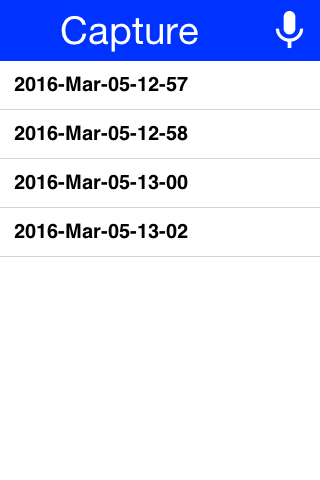- java.lang.Object
-
- com.codename1.capture.Capture
-
public class Capture extends Object
Capturecan "capture" media files from the device e.g. record audio, video and snap photos. Notice that files returned by this class are potentially temporary files and might be deleted by the OS in the future.
The code below demonstrates the capturing of a photo thru this API:
The code below demonstrates capturing and playing back audio files using this API:

-
-
Constructor Summary
Constructors Constructor and Description Capture()
-
Method Summary
All Methods Static Methods Concrete Methods Modifier and Type Method and Description static StringcaptureAudio()Capture the audio, blocking version that holds the EDT; alternatively you can use the Media API.static voidcaptureAudio(ActionListener response)This method tries to invoke the device native hardware to capture audio.static StringcaptureAudio(MediaRecorderBuilder recordingOptions)Capture the audio, blocking version that holds the EDT; alternatively you can use the Media API.static voidcaptureAudio(MediaRecorderBuilder recorderOptions, ActionListener response)This method tries to invoke the device native hardware to capture audio.static StringcapturePhoto()Invokes the camera and takes a photo synchronously while blocking the EDTstatic voidcapturePhoto(ActionListener response)This method tries to invoke the device native camera to capture images.static StringcapturePhoto(int width, int height)Invokes the camera and takes a photo synchronously while blocking the EDT, the sample below demonstrates a simple usage and applying a mask to the resultstatic StringcaptureVideo()Same as captureVideo only a blocking version that holds the EDTstatic voidcaptureVideo(ActionListener response)This method tries to invoke the device native camera to capture video.static StringcaptureVideo(VideoCaptureConstraints constraints)Same ascaptureVideo(com.codename1.capture.VideoCaptureConstraints, com.codename1.ui.events.ActionListener)only a blocking version that holds the EDT.static voidcaptureVideo(VideoCaptureConstraints constraints, ActionListener response)Captures video with some constraints, like width, height, and max length.static booleanhasCamera()Returns true if the device has camera false otherwise.
-
-
-
Method Detail
-
hasCamera
public static boolean hasCamera()
Returns true if the device has camera false otherwise.- Returns:
- true if the device has a camera
-
capturePhoto
public static void capturePhoto(ActionListener response)
This method tries to invoke the device native camera to capture images. The method returns immediately and the response will be sent asynchronously to the given ActionListener Object The image is saved as a jpeg to a file on the device. use this in the actionPerformed to retrieve the file path String path = (String) evt.getSource(); if evt returns null the image capture was canceled by the user.- Parameters:
response- a callback Object to retrieve the file path- Throws:
RuntimeException- if this feature failed or unsupported on the platform
-
capturePhoto
public static String capturePhoto()
Invokes the camera and takes a photo synchronously while blocking the EDT- Returns:
- the photo file location or null if the user canceled
-
captureAudio
public static String captureAudio()
Capture the audio, blocking version that holds the EDT; alternatively you can use the Media API.- Returns:
- the audio file location or null if the user canceled
-
captureAudio
public static String captureAudio(MediaRecorderBuilder recordingOptions)
Capture the audio, blocking version that holds the EDT; alternatively you can use the Media API.- Returns:
- the audio file location or null if the user canceled
- Since:
- 7.0
-
captureVideo
public static String captureVideo()
Same as captureVideo only a blocking version that holds the EDT- Returns:
- the photo file location or null if the user canceled
-
captureVideo
public static String captureVideo(VideoCaptureConstraints constraints)
Same ascaptureVideo(com.codename1.capture.VideoCaptureConstraints, com.codename1.ui.events.ActionListener)only a blocking version that holds the EDT.- Parameters:
constraints-- Returns:
- A video file location or null if the user canceled.
- Since:
- 7.0
-
capturePhoto
public static String capturePhoto(int width, int height)
Invokes the camera and takes a photo synchronously while blocking the EDT, the sample below demonstrates a simple usage and applying a mask to the result

- Parameters:
width- the target width for the image if possible, some platforms don't support scaling. To maintain aspect ratio set to -1height- the target height for the image if possible, some platforms don't support scaling. To maintain aspect ratio set to -1- Returns:
- the photo file location or null if the user canceled
-
captureAudio
public static void captureAudio(ActionListener response)
This method tries to invoke the device native hardware to capture audio. The method returns immediately and the response will be sent asynchronously to the given ActionListener Object The audio is saved to a file on the device. use this in the actionPerformed to retrieve the file path String path = (String) evt.getSource();- Parameters:
response- a callback Object to retrieve the file path- Throws:
RuntimeException- if this feature failed or unsupported on the platform
-
captureAudio
public static void captureAudio(MediaRecorderBuilder recorderOptions, ActionListener response)
This method tries to invoke the device native hardware to capture audio. The method returns immediately and the response will be sent asynchronously to the given ActionListener Object The audio record settings are specified in the recorderOptions parameter.use this in the actionPerformed to retrieve the file path. String path = (String) evt.getSource();
- Parameters:
response- a callback Object to retrieve the file path- Throws:
RuntimeException- if this feature failed or unsupported on the platform- Since:
- 7.0
-
captureVideo
public static void captureVideo(VideoCaptureConstraints constraints, ActionListener response)
Captures video with some constraints, like width, height, and max length. Video constraints may not be supported on all platforms. UseVideoCaptureConstraints.isSupported()andVideoCaptureConstraints.isSizeSupported()to check whether constraints are supported on the current platform. If constraints are not supported, then, in the worst case, this will fall back to just usecaptureVideo(com.codename1.ui.events.ActionListener), i.e. capture with no constraints.- Parameters:
constraints- The constraints to use for the video capture.response- a callback Object to retrieve the file path- Since:
- 7.0
-
captureVideo
public static void captureVideo(ActionListener response)
This method tries to invoke the device native camera to capture video. The method returns immediately and the response will be sent asynchronously to the given ActionListener Object The video is saved to a file on the device. use this in the actionPerformed to retrieve the file path String path = (String) evt.getSource();- Parameters:
response- a callback Object to retrieve the file path- Throws:
RuntimeException- if this feature failed or unsupported on the platform- See Also:
captureVideo(com.codename1.capture.VideoCaptureConstraints, com.codename1.ui.events.ActionListener)
-
-